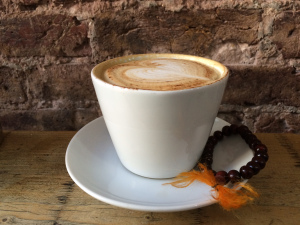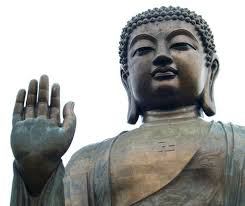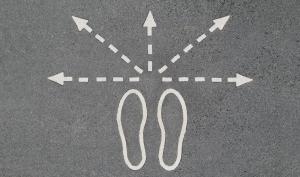
I recently took the Refuge Vow. Whilst I have long considered myself a Buddhist (I have been meditating for some 6 years now), the taking of theRefuge Vow marks the formal step: a publicly witnessed commitment towards 3 aspects of the path that offer shelter from the vulnerability of being human: the Buddha, the Dharma, and the Sangha.
What does this mean exactly? Traditionally, someone declaring themselves as Buddhist commits to working with their day-to-day experience in a way that differs to how we might normally deal with the challenges life can throw at us. I’ll come back to some ways we may turn to ‘false’ refuge later in this post – but very simply we can consider habits that we turn to for comfort, or to numb our pain.
Taking refuge is putting trust in:
The Buddha. We can think of the Buddha as the historical Buddha (the story of the Prince Siddhārtha Gautama who meditated and saw the truth of our suffering as humans), but equally this can be any awakened* figure who inspires us to live differently. In Western psychology, we might consider someone who has ‘self-actualised’: someone who has realised they are not solid or separate, but rather they are beings-in-flux and inter-connected with all other beings. In taking refuge, there is also trust in one’s own Buddha-nature**.
The Dharma. This is the sanskrit word for ‘principles’, and simply refers to the teachings of the Buddha. When the historical Buddha attained his enlightenment, he didn’t declare a doctrine, or ask anyone to believe him (or have faith in his path), but rather it was an invitation to try what he did: if it works, great; if not, disregard it. In other words, test things out and only adopt them if they match your own experience. This is why I love the description of the Buddha as a scientist.
The Sangha. This is the sanskrit word for ‘community’.Taking refuge in the Sangha is committing to relationships with others on the path: to share experiences, and to learn how to relate in a skilful, non-harming way. Meditation might be a solitary activity, but actually as a Buddhist, one sits and turns the attention inward only to learn about the nature of one’s own mind. Then, and only then, can we go in to relationship with others. Put simply, meditation prepares us for relationship with others: to help us differentiate what is our ‘stuff’ rather than pointing to Other as the problem!
With trust in this triumvirate, every situation, no matter how hard, becomes workable.
“To be fully alive, fully human, and completely awake is to be continually thrown out of the nest”
~ Pema Chodron
 I’ve spent this past week pondering how taking the Vow will impact my daily life: personally and professionally. Working in health and well-being, it is natural for me to turn to ideas of the hippocratic oath. Historically, this vow was taken by physicians, and in its original form required a buddha-oathnew physician to swear, by a number of healing gods, to uphold specific ethical standards. There are obvious parallels here – Buddhists are committing to the teachings of the Buddha including those on non-harm, skilful means, and ethics. Psychotherapists are not bound to the same hippocratic oath, although we do work to codes of ethics provided by organisations such as the BACP and UKCP. Taking a vow that emphasises qualities like compassion makes sense to me given how important it is to bring certain core conditions*** to the therapeutic relationship. Yet, there are other ways in which the taking of the Vow has helped me consider mental / emotional well-being – my own, and that of my therapy clients and mindfulness-meditation students. This is as relevant to non-Buddhists and non-meditators…
I’ve spent this past week pondering how taking the Vow will impact my daily life: personally and professionally. Working in health and well-being, it is natural for me to turn to ideas of the hippocratic oath. Historically, this vow was taken by physicians, and in its original form required a buddha-oathnew physician to swear, by a number of healing gods, to uphold specific ethical standards. There are obvious parallels here – Buddhists are committing to the teachings of the Buddha including those on non-harm, skilful means, and ethics. Psychotherapists are not bound to the same hippocratic oath, although we do work to codes of ethics provided by organisations such as the BACP and UKCP. Taking a vow that emphasises qualities like compassion makes sense to me given how important it is to bring certain core conditions*** to the therapeutic relationship. Yet, there are other ways in which the taking of the Vow has helped me consider mental / emotional well-being – my own, and that of my therapy clients and mindfulness-meditation students. This is as relevant to non-Buddhists and non-meditators…
Gateways to emotional well-being
Sanskrit words such as Buddha, Dharma, Sangha can be off putting – so I really value the translations and interpretations of Buddhist teacher and clinical psychologist Tara Brach. She offers the 3 gateways of ‘True refuge’ as archetypes:
- Awareness. Refuge in the Buddha, or Buddha nature is refuge in the awakened heart and mind. We can look to others for inspiration: to see and contemplate their awakeness, openness and stillness; and to practice remembering our own nature is also one of clarity rather than a neurotic human identified with ego – we just need to discover it! Brach considers this the most challenging of the refuges, so often presents this as the last of the three.
- Truth. Refuge in the Dharma points to the truth of the present moment. We start waking up when we pay attention to the present moment. The quality of awareness brings us in to contact with the moment by moment experience: to notice when we are caught up in regrets of the past, or anticipatory fear of the future. Awareness helps us notice when we are caught up in habitual reactivity, to notice our thoughts, feelings and emotions. In this way, we are developing a watcher of our experience as well as being IN the experience. Allowing life to be just as it is, we can perceive truth, reality.
- Love. As Brach explains “quieting the thoughts and looking into awareness often requires a real softening and opening of the heart—this gives us a sense of safety and allows us to relax and entrust ourselves to reality. For many people, life has brought much wounding, and this makes it harder to stay with reality. Relationships with others (although often the source of wounding) – whether the love of a pet, a family member, a good friend, or belonging in community – can offer the gateway to this opening of the heart.
Doing it differently
I have been using the expression ‘true refuge’ in this post so far. ‘False refuge’ is what many people are more familiar with – the strategies we employ when feeling hurt, angry or confused. These can take a number of guises, and most of the time we are not aware that we are distracting ourselves from the painful feelings. Obvious examples would be eating when we need comfort or feel alone; drinking heavily when we’ve experienced rejection; or working long-hours to avoid going home to a volatile situation at home.
One common strategy I come across in my therapeutic work is how clients have learnt (very effectively) to use thinking as a protection from their feelings. This is a less obvious ‘refuge’, as it is hard to separate our ‘selves’ from the thinking mind (whereas the others above are activities we can watch ourselves doing). We could protest that we cannot help but think. To one extent, that IS true. However, at some level, thinking OVER feeling IS a choice. Sometimes it is a choice made as a young child, and a very sensible choice if that child is exposed to abuse or a lack of love. Rationalising why a parent is not paying attention, or disconnecting from the physical pain of trauma is totally understandable and allows the child to survive an otherwise intolerable situation. However, this strategy becomes ingrained…and with time, it starts to hinder rather than serve. As I explained to one client recently – the obsessing mind is trying to work out a way to stay protected from something that has already happened. The defence is obsolete – but we need to find a way to drop the defence, and to drop it safely.
Our false refuges tend to have a common root – to avoid the present moment. Whether we busy ourselves to avoid ‘boredom’ or to validate our existence, without the strategies of distraction, we would contact our pain directly. It can therefore feel counter-intuitive (or in fact, down-right scary!) to ‘lean in’ – to drop the strategy, and experience the pain, the ache. Yet, this represents the one way in which we can escape the pain in the long-term. Drinking too much after ‘a tough day’ or eating rich food to cheer one’s mood does little to remove the problem: it simply delays us thinking about it. In short, our habits of reaching for comfort or numbing don’t last – in fact ramp up our experience of suffering (whether that be a hang-over, or setting down additive patterning).
Can a leopard change its spots?
 Choosing to change is hard. We have to first recognise the usefulness of the strategies of false refuge: to bring compassion to ourselves for having needed them, and employing them for so long. Yes, we can simply apply ‘discipline’. But those statements of ‘will-power’ are very different to taking vows like the Refuge Vow. Saying “I won’t over-eat again” and going ‘cold-turkey’ is like kicking away the crutch of a person with a broken leg. In my personal experience, and in my work with others, meditation has become a useful ally: it helps us recognise our experience, to notice the longing for the pain to go away and the moment we contemplate the ‘weapon of choice’ for providing comfort and respite. It is a long, slow path however. And, we WILL slip-up, or ‘give-in’. Like a horse rider, we do our best to dust ourselves off, and get back in to the saddle. Again, meditation can help us observe any patterns of judgement when we fall down – and to help us pick ourselves up more gently.
Choosing to change is hard. We have to first recognise the usefulness of the strategies of false refuge: to bring compassion to ourselves for having needed them, and employing them for so long. Yes, we can simply apply ‘discipline’. But those statements of ‘will-power’ are very different to taking vows like the Refuge Vow. Saying “I won’t over-eat again” and going ‘cold-turkey’ is like kicking away the crutch of a person with a broken leg. In my personal experience, and in my work with others, meditation has become a useful ally: it helps us recognise our experience, to notice the longing for the pain to go away and the moment we contemplate the ‘weapon of choice’ for providing comfort and respite. It is a long, slow path however. And, we WILL slip-up, or ‘give-in’. Like a horse rider, we do our best to dust ourselves off, and get back in to the saddle. Again, meditation can help us observe any patterns of judgement when we fall down – and to help us pick ourselves up more gently.
Taking true refuge need not be a formal step in the way I have chosen. Rather, it can act as a useful metaphor in looking to do things differently. People often come to therapy, or take up a spiritual practice in the hope that it will (at long last!) be THE answer to a long-held search for a less stressful or more contented life. Both rely on doing things differently, to build awareness of thoughts and stories, to lean in to the feelings, and to de-construct habits. Neither are instant fixes, and in fact can feel counter-intuitive and awkward. But, to leave you with one of my favourite quotes…
“Insanity is doing the same thing over and over again and expecting different results”
~ Albert Einstein
——–
*In this context, ‘awake’ means to have come to our senses, to step out of living in automatic pilot, to be in reality as it is happening (and not caught up in projections or living on past scripts). Someone who is enlightened still has thoughts, feelings and emotions – but they know they are not defined by those thoughts, feelings, emotions.
**People may see figures of Buddhas and mis-construe Buddhists are worshipping these statues like a God. In fact, they simply represent the aspiration to awaken one’s own mind. There are no external saviours in Buddhism, in fact it is often considered the ‘Path to becoming human’: simply a psychology and science of the mind.
***The ‘core conditions’ are emphasised in the Humanistic approaches to therapy: empathy, unconditional positive regard, and congruence
